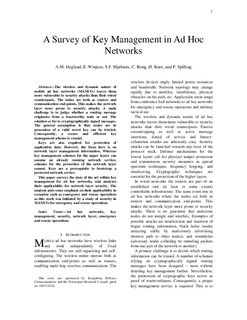| dc.contributor.author | Hegland, Anne Marie | |
| dc.contributor.author | Winjum, Eli | |
| dc.contributor.author | Mjølsnes, Stig Frode | |
| dc.contributor.author | Rong, Chunming | |
| dc.contributor.author | Kure, Øivind | |
| dc.contributor.author | Spilling, Pål | |
| dc.date.accessioned | 2017-11-14T15:37:56Z | |
| dc.date.available | 2017-11-14T15:37:56Z | |
| dc.date.created | 2007-01-08T11:15:12Z | |
| dc.date.issued | 2006 | |
| dc.identifier.citation | IEEE Communications Surveys and Tutorials. 2006, 8 (3), 48-66. | nb_NO |
| dc.identifier.issn | 1553-877X | |
| dc.identifier.uri | http://hdl.handle.net/11250/2466282 | |
| dc.description.abstract | The wireless and dynamic nature of mobile ad hoc networks (MANETs) leaves them more vulnerable to security attacks than their wired counterparts. The nodes act both as routers and as communication end points. This makes the network layer more prone to security attacks. A main challenge is to judge whether or not a routing message originates from a trustworthy node. The solution thus far is cryptographically signed messages. The general assumption is that nodes in possession of a valid secret key can be trusted. Consequently, a secure and efficient key-management scheme is crucial. Keys are also required for protection of application data. However, the focus here is on network-layer management information. Whereas keymanagement schemes for the upper layers can assume an already running network service, schemes for the protection of the network layer cannot. Keys are a prerequisite to bootstrap a protected network service. This article surveys the state of the art within key management for ad hoc networks, and analyzes their applicability for network-layer security. The analysis puts some emphasis on their applicability in scenarios such as emergency and rescue operations, as this work was initiated by a study of security in MANETs for emergency and rescue operations. | nb_NO |
| dc.language.iso | eng | nb_NO |
| dc.publisher | Institute of Electrical and Electronics Engineers (IEEE) | nb_NO |
| dc.title | Survey of Key Management in Ad Hoc Networks | nb_NO |
| dc.type | Journal article | nb_NO |
| dc.type | Peer reviewed | nb_NO |
| dc.description.version | acceptedVersion | nb_NO |
| dc.source.pagenumber | 48-66 | nb_NO |
| dc.source.volume | 8 | nb_NO |
| dc.source.journal | IEEE Communications Surveys and Tutorials | nb_NO |
| dc.source.issue | 3 | nb_NO |
| dc.identifier.doi | 10.1109/COMST.2006.253271 | |
| dc.identifier.cristin | 376157 | |
| dc.description.localcode | © 2006 IEEE. Personal use of this material is permitted. Permission from IEEE must be obtained for all other uses, in any current or future media, including reprinting/republishing this material for advertising or promotional purposes, creating new collective works, for resale or redistribution to servers or lists, or reuse of any copyrighted component of this work in other works. | nb_NO |
| cristin.unitcode | 194,63,30,0 | |
| cristin.unitcode | 194,63,1,0 | |
| cristin.unitname | Institutt for informasjonssikkerhet og kommunikasjonsteknologi | |
| cristin.unitname | IE fakultetsadministrasjon | |
| cristin.ispublished | true | |
| cristin.fulltext | postprint | |
| cristin.qualitycode | 2 | |
